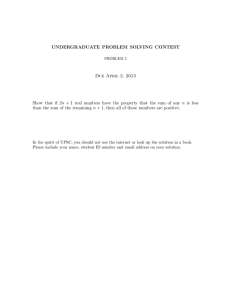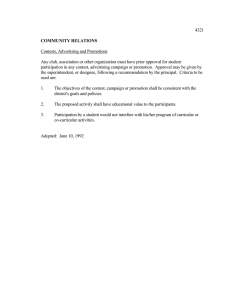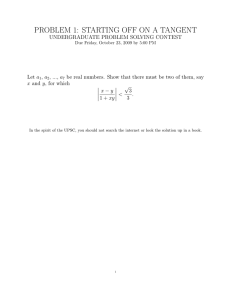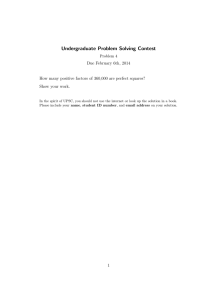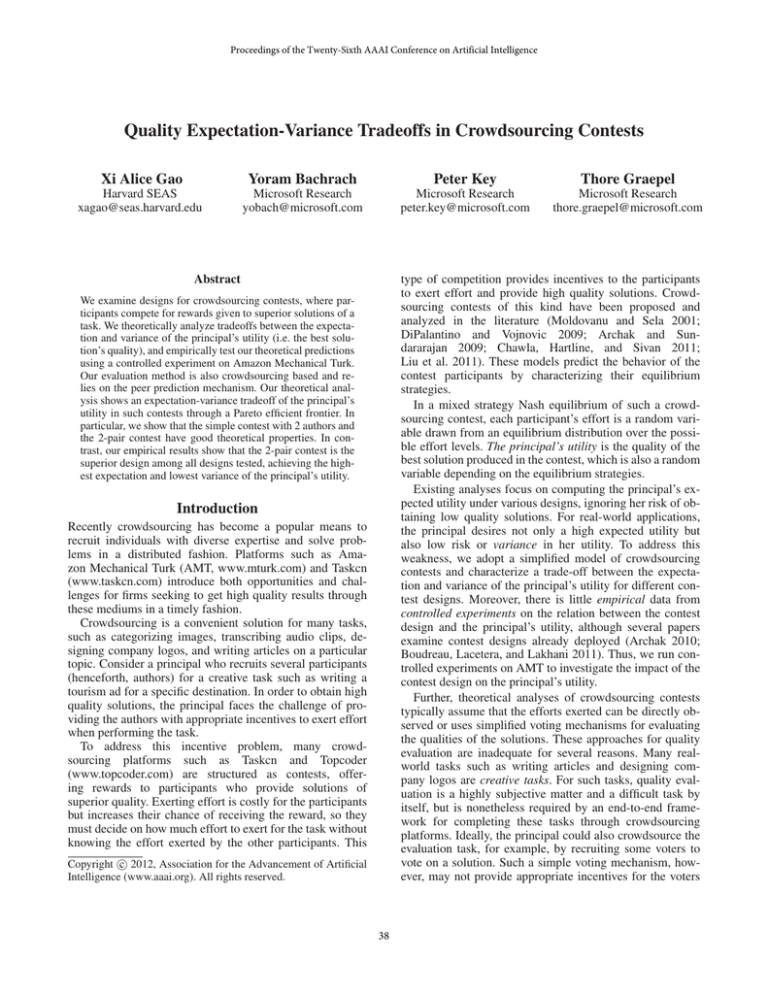
Proceedings of the Twenty-Sixth AAAI Conference on Artificial Intelligence
Quality Expectation-Variance Tradeoffs in Crowdsourcing Contests
Xi Alice Gao
Yoram Bachrach
Peter Key
Thore Graepel
Harvard SEAS
xagao@seas.harvard.edu
Microsoft Research
yobach@microsoft.com
Microsoft Research
peter.key@microsoft.com
Microsoft Research
thore.graepel@microsoft.com
type of competition provides incentives to the participants
to exert effort and provide high quality solutions. Crowdsourcing contests of this kind have been proposed and
analyzed in the literature (Moldovanu and Sela 2001;
DiPalantino and Vojnovic 2009; Archak and Sundararajan 2009; Chawla, Hartline, and Sivan 2011;
Liu et al. 2011). These models predict the behavior of the
contest participants by characterizing their equilibrium
strategies.
In a mixed strategy Nash equilibrium of such a crowdsourcing contest, each participant’s effort is a random variable drawn from an equilibrium distribution over the possible effort levels. The principal’s utility is the quality of the
best solution produced in the contest, which is also a random
variable depending on the equilibrium strategies.
Existing analyses focus on computing the principal’s expected utility under various designs, ignoring her risk of obtaining low quality solutions. For real-world applications,
the principal desires not only a high expected utility but
also low risk or variance in her utility. To address this
weakness, we adopt a simplified model of crowdsourcing
contests and characterize a trade-off between the expectation and variance of the principal’s utility for different contest designs. Moreover, there is little empirical data from
controlled experiments on the relation between the contest
design and the principal’s utility, although several papers
examine contest designs already deployed (Archak 2010;
Boudreau, Lacetera, and Lakhani 2011). Thus, we run controlled experiments on AMT to investigate the impact of the
contest design on the principal’s utility.
Further, theoretical analyses of crowdsourcing contests
typically assume that the efforts exerted can be directly observed or uses simplified voting mechanisms for evaluating
the qualities of the solutions. These approaches for quality
evaluation are inadequate for several reasons. Many realworld tasks such as writing articles and designing company logos are creative tasks. For such tasks, quality evaluation is a highly subjective matter and a difficult task by
itself, but is nonetheless required by an end-to-end framework for completing these tasks through crowdsourcing
platforms. Ideally, the principal could also crowdsource the
evaluation task, for example, by recruiting some voters to
vote on a solution. Such a simple voting mechanism, however, may not provide appropriate incentives for the voters
Abstract
We examine designs for crowdsourcing contests, where participants compete for rewards given to superior solutions of a
task. We theoretically analyze tradeoffs between the expectation and variance of the principal’s utility (i.e. the best solution’s quality), and empirically test our theoretical predictions
using a controlled experiment on Amazon Mechanical Turk.
Our evaluation method is also crowdsourcing based and relies on the peer prediction mechanism. Our theoretical analysis shows an expectation-variance tradeoff of the principal’s
utility in such contests through a Pareto efficient frontier. In
particular, we show that the simple contest with 2 authors and
the 2-pair contest have good theoretical properties. In contrast, our empirical results show that the 2-pair contest is the
superior design among all designs tested, achieving the highest expectation and lowest variance of the principal’s utility.
Introduction
Recently crowdsourcing has become a popular means to
recruit individuals with diverse expertise and solve problems in a distributed fashion. Platforms such as Amazon Mechanical Turk (AMT, www.mturk.com) and Taskcn
(www.taskcn.com) introduce both opportunities and challenges for firms seeking to get high quality results through
these mediums in a timely fashion.
Crowdsourcing is a convenient solution for many tasks,
such as categorizing images, transcribing audio clips, designing company logos, and writing articles on a particular
topic. Consider a principal who recruits several participants
(henceforth, authors) for a creative task such as writing a
tourism ad for a specific destination. In order to obtain high
quality solutions, the principal faces the challenge of providing the authors with appropriate incentives to exert effort
when performing the task.
To address this incentive problem, many crowdsourcing platforms such as Taskcn and Topcoder
(www.topcoder.com) are structured as contests, offering rewards to participants who provide solutions of
superior quality. Exerting effort is costly for the participants
but increases their chance of receiving the reward, so they
must decide on how much effort to exert for the task without
knowing the effort exerted by the other participants. This
c 2012, Association for the Advancement of Artificial
Copyright Intelligence (www.aaai.org). All rights reserved.
38
dated belief of the quality, denoted as pi2 ∈ [0, 1]. The second report pi2 is a prediction of the likelihood that another
random critic receives a h signal by reading the solution.
Given the two belief reports, we infer that critic i received
the h signal if pi2 > pi1 , and that she received the l signal if
pi2 < pi1 . The payment of critic i depends on her two belief
reports and on the signal received by another random critic
r(i) evaluating the same solution. If critic r(i) received the
h signal, then the payment of critic i is ∑ j=1,2 (2pij − (pij )2 ).
Otherwise, if critic r(i) received the l signal, critic i is paid
∑ j=1,2 (1 − (pij )2 ). The overall rating of a solution is the
fraction of h signals from among all the inferred signals.
Witkowski and Parkes (2012) showed that for the above payment rules, truthful reporting is a Bayesian Nash equilibrium, making this method an incentive compatible mechanism.
to report their opinions honestly. To this end, we propose
to use an existing mechanism, called the peer prediction
method, to elicit honest subjective feedback from the participants (henceforth, critics) about the qualities of the solutions (Prelec 2004; Miller, Resnick, and Zeckhauser 2005;
Witkowski and Parkes 2012). Such methods have attractive
theoretical truthfulness guarantees. We use the term authorcritic framework to refer to an end-to-end system, which
incorporates the crowdsourcing contest for collecting solutions and the peer prediction method for quality evaluation.
We implement this end-to-end system on AMT and empirically examine the principal’s expected utility and risk under
different contest designs through a controlled experiment,
comparing our findings with the theoretical predictions.
Preliminaries and Related Work
Several game theoretic models have been proposed for analyzing the behavior of participants in contests by modeling these contests as all-pay auctions (Moldovanu and Sela
2001; DiPalantino and Vojnovic 2009; Archak and Sundararajan 2009; Chawla, Hartline, and Sivan 2011; Liu et
al. 2011; Siegel 2009). As opposed to such analysis, we focus not only on the expectation of the principal’s utility but
also on its variance, and the trade-offs between the two.
Behavior in contest settings has also been studied empirically, mostly using real-world datasets based on deployed
mechanisms already running “in the field” (Archak 2010;
Boudreau, Lacetera, and Lakhani 2011), rather than through
controlled experiments. In contrast, we verify our theoretical
predictions through a controlled experiment, which involves
completing and evaluating the solution to a creative task in a
crowdsourcing environment. Also, empirical studies of allpay auctions such as (Gneezy and Smorodinsky 2006) may
shed some light on participant behavior in these contests.
Our experimental methodology builds on peer prediction
methods for evaluating the quality of solutions to the creative
task. Such methods were proposed to elicit honest subjective feedback from users about their experiences with products of unknown quality (Miller, Resnick, and Zeckhauser
2005). Since the true subjective opinion is neither observable nor verifiable, peer prediction methods reward participants based on the correlation between their reported opinions to induce a truthful equilibrium outcome. Among variants of the initial peer prediction method (Miller, Resnick,
and Zeckhauser 2005; Prelec 2004; Jurca and Faltings 2005;
2007; 2009; Witkowski and Parkes 2012), we adopt the
one proposed by Witkowski and Parkes (2012) (WP), which
has several advantages such as not relying on the common
knowledge assumption, requiring only a finite number of
participants, and being individually rational.
We apply the WP method as follows. For each solution,
we assume that a critic receives the h (high) signal if the
quality of the solution exceeds her prior expectation and that
she receives the l (low) signal otherwise. Before examining
the solution, critic i is asked to report her belief of the expected quality of the solution, denoted by pi1 ∈ [0, 1]. Then,
after reading the solution and deciding whether its quality
exceeded her prior expectation or not (i.e. whether she received a h or l signal), critic i is asked to report her up-
The Principal’s Utility —
Expectation-Variance Tradeoffs
We study how different contest designs affect the principal’s
utility. We use some simplifying assumptions to make our
theoretical analysis feasible. First, in contrast to some contest models, we assume that all authors are of equal skill,
and that the quality of the solution produced by each author
is equal to the amount of effort she exerted to produce the
solution (see (DiPalantino and Vojnovic 2009) for a model
with different skill levels). We thus refer to the effort exerted for a solution and the quality of the solution interchangeably. We also assume that the principal has a blackbox which can be used to accurately determine the relative
qualities of solutions. For the empirical analysis we use the
WP method (Witkowski and Parkes 2012) as an implementation of such a black-box.
Simple Contest
Consider the simple contest described as follows. A principal recruits n authors to produce solutions to a task in a
simple contest and offers a single reward m for the solution
of the highest quality. In this contest, author i chooses to exert a certain amount of effort ei , which is measured in the
same monetary units as the reward. Each author must exert a non-negative amount of effort, and no rational author
would exert more effort than the reward m. The participant
who exerted the most effort, i.e. arg maxi ei , wins the contest,
gets the reward m, and obtains a utility of m − ei , whereas
any other losing author j has a utility of −e j . Since the exerted effort cannot be recovered, this crowdsourcing contest
is essentially an “all-pay” auction. The principal who runs
the contest is interested in the best possible solution to the
task at hand, and chooses the best solution, so her utility is
maxi ei . Note that this is different from an all-pay auction
in which the utility of the auctioneer is the sum of the bids
made by the participants.
For this simple contest, it is easy to see that a pure strategy Nash equilibrium does not exist. Thus, we characterize
a symmetric mixed Nash equilibrium of this simple contest
and analyze the principal’s utility.
39
Surprisingly, by equation (2), as the number of authors
approaches infinity, the expectation of the principal’s utility
decreases and approaches m2 . By equation (3), the variance
of the principal’s utility, equivalently the principal’s risk,
2
increases and approaches m12 as the number of authors approaches infinity.
Intuitively, as the number of authors increases, for a fixed
mixed strategy, the probability for each author to win decreases. Therefore, at the symmetric equilibrium, the mixed
strategy of each author becomes skewed, putting more probability mass on exerting less effort. The expectation decreases because the effect of the skewing outweighs the effect of having more authors.
For a simple crowdsourcing contest with n authors, our
analysis shows that the optimal design, both in terms of maximizing expectation and minimizing variance, is recruiting 2
authors, achieving an expected utility of 2m
3 for the principal.
Theorem 1. For the simple contest with n authors, there exists a symmetric Nash equilibrium where each author plays
the same mixed strategy with full support over [0, m] given
by the cumulative distribution function (CDF):
F(x) =
x
1
n−1
m
(1)
Proof. For x ∈ [0, m], let F(x) and f(x) denote the cumulative distribution function (CDF) and the probability density
function (PDF) of the mixed strategy. The expected payoff
for exerting effort x ∈ [0, m] is u(x) = F(x)n−1 m − x.
In a mixed strategy Nash equilibrium, the expected payoff
of each author to exert any amount of effort x ∈ [0, m] is the
same. Thus, we have u(x) = c, ∀x ∈ [0, m], for a constant c.
Then applying the fact that F(m) = 1 since F(x) is a valid
cumulative distribution function, we can derive that c = 0.
Therefore, at this symmetric Nash equilibrium, each author’s mixed strategy has the CDF:
F(x) =
x
2
However, the variance m18 is quite large, resulting in high risk
for the principal who desires a good guarantee for the quality she would obtain. We now explore alternative designs
that can potentially achieve a lower variance.
1
n−1
m
Alternative Contest Designs
Suppose the principal has a fixed budget of m = 1 wlog. The
principal’s objective is to design the contest so as to maximize the expectation and to minimize the variance of the
principal’s utility. We say that a design A Pareto dominates
design B if design A offers both a higher expectation and
a lower variance. We wish to find an efficient frontier on
which improving either the expectation or the variance must
require sacrificing the other. We visualize our results on a
scatter plot, where each point represents a specific design;
its X-value is the expectation of the principal’s utility and
its Y-value is the variance. In the plot, we seek points in the
bottom right corner, with high expectation and low variance.
At the symmetric equilibrium given in Theorem 1, the
principal’s utility is the best solution’s quality, which is a
random variable drawn from a distribution depending on the
equilibrium mixed strategies. In Theorem 2, we derive expressions for the expectation and the variance of the principal’s utility.
Theorem 2. Under the symmetric equilibrium in Theorem 1, the expectation and the variance of the quality of the
best solution are:
mn
(2)
E(X1 ) =
2n − 1
m2 n(n − 1)2
V(X1 ) =
(3)
(3n − 2)(2n − 1)2
Design 1: Simple Contest with $1 budget: For all simple
contests with budget m = 1, by Theorem 2, the pair contest
(n = 2) achieves the highest expectation 23 and the lowest
1
variance 18
of the principal’s utility, giving a single point on
the efficient frontier.
Inspired by the above analysis, we consider the following
design of dividing a total of n authors into equal sized groups
each containing a small number of authors. Having a small
number of authors in each group induces the authors to put
more probability on higher effort levels. However, the maximum possible effort for each author is also smaller since the
reward for each group is smaller. Below we examine how
this design will affect the expectation and the variance of
the principal’s utility.
Proof. Let X1 be the random variable for principal’s utility
with a PDF fmax (x) and a CDF Fmax (x). Then we can derive
the expectation E(X1 ) and the variance V (X1 ) as follows:
x n
n−1
Fmax (x) =F(x)n =
m
x 1
d
n
n−1
fmax (x) = Fmax (x) =
dx
m(n − 1) m
m
mn
E(X1 ) =
xfmax (x)dx =
2n
−1
0
V(X1 ) =
=
m
0
Design 2: Contests of groups of k authors: Let the principal divide n authors into nk groups of size k (assuming
1 < k < n and n divides k) and offer a reward nk to the best
solution in each group. This design essentially groups nk simple contests of k authors together while keeping a unit budget. By Theorem 1, at a symmetric equilibrium, each author
(x − E(X1 ))2 fmax (x)dx
m2 n(n − 1)2
(3n − 2)(2n − 1)2
40
plays a mixed strategy over [0, nk ] with CDF:
nx 1
k−1
F(x) =
(4)
k
Denote by X2 the random variable for the principal’s utility.
The expectation and the variance of X2 are:
1
k
E(X2 ) =
=O
n+k−1
n
2
1
k (k − 1)2
=
O
V(X2 ) =
n(n + k − 1)2 (n + 2k − 2)
n4
As n → ∞, the expectation and variance approach 0 on
the order of 1n and n14 respectively. Among all such contests,
the contest with groups of 2 authors (k = 2) dominate the
rest as they achieve both higher expectation and lower variance. Note that the pair contest (n = 2) and the 2-pair contest
(n = 4) achieve relatively high expected utility for the principal, but neither of them Pareto dominates the other. We
now focus on contests with 2 or 4 authors and characterize
an efficient frontier by varying the reward rules.
Design 3: Varying rewards of 2 sub-contests: Consider
recruiting 4 authors and running 2 contests A and B with 2
authors in each. Let contest A and B offer rewards of r and
1 − r respectively. Without loss of generality, we assume r ∈
[0.5, 1]. Let X3 denote the random variable of the principal’s
utility. The expectation and variance of X3 are:
1−r
r
2 2
4
4
x
dx
+
x dx
E(X3 ) =
2
r2 (1 − r)2
0
1−r r
1−r
4
(x − E(X3 ))2 2
x3 dx
V (X3 ) =
r (1 − r)2
0
r
2
(x − E(X3 ))2 2 xdx
+
r
1−r
Numerical calculations for this design show that both expectation and variance increase as r increases from 0.5 to 1.
In Figure 1, the relationship follows a concave curve.
Design 4: Two-phase contest with 4 authors: Consider a
contest with 2 pairs of authors in which the reward is determined in two phases. After every author submits an entry, in
the first phase, each pair of authors competes for a reward of
r
2 . Then in the second phase, the best solution among all gets
a reward of 1 − r. Note that the quad contest (design 1 with
n = 4) and the 2-pair contest are extreme cases of this design for r = 0 and r = 1 respectively. We find the symmetric
equilibrium for this contest.
Theorem 3. At a symmetric equilibrium of the two-phase
contest, the CDF F(x) of the mixed strategy of each author
is the solution to the following equation
r
(1 − r)F(x)3 + F(x) = x
(5)
2
Proof. At a symmetric equilibrium of this game, we use
F(x) to denote the CDF of each author’s mixed strategy over
[0, 1− 2r ]. By writing out the expression of each author’s utility function in terms of the effort exerted and applying the
definition of a CDF, we can derive the implicit expression
for F(x) given in equation 5. The derivation is similar to the
one used in Theorem 1 and we omit the derivation here.
+ +3++
$
/#
(,!!
- ! "
!
+ +2++
!
+ +1++
- !/
+ +0++
$
-#
(,!!
+ +/++
+ +.++
+ +-++
- $
-#
(+%0!!
+ +,++
+ ++++
+ .2+
+ /-+
+ /2+
+ 0-+
+ 02+
+ 1-+
+ 12+
Figure 1: Expectation and Variance in Contest Designs
' '(/'
)#
' '(.'
)#+
' '(,'
' '(*'
' '(('
' ''/'
)#
!
) %'",
' ''.'
' '','
' */'
' +''
' +('
' +)'
' +*'
' ++'
' +,'
' +-'
Figure 2: Point Z on the Expectation-Variance Frontier
For each r ∈ [0, 1], we can derive an explicit expression for
the CDF of the mixed strategy. For example, when r = 12 , the
CDF of the mixed strategy is given below.
1
1
3
3
2
− −x + x2 +
(6)
F(x) = x + x +
216
216
This example shows that the explicit expression of F(x)
is cumbersome to work with analytically. Thus, we resort
to numerically computing the values of the variance and the
expectation of the principal’s utility. In the following formulas, let r ∈ [0, 1] and let X4 denote the random variable of the
quality of the best solution.
1− r 2
d
4
E(X4 ) =
F(x) dx
x
(7)
dx
0
1− r
2
d
F(x)4 dx
(x − E(X4 ))2
(8)
V (X4 ) =
dx
0
Numerically calculations show that the expectation and the
variance both increase as r decreases from 1 to 0. In Figure 1,
the relationship appears to follow a convex curve.
The Expectation-Variance Efficient Frontier
Figure 1 shows the efficient frontier for the contests we analyzed. Each point represents a contest design. Every point
on a line corresponds to a contest with particular parameters.
Figure 1 shows that the curves for designs 3 and 4 intersect at a point, which we denote by Z. Figure 2 zooms in on
the area around Z. The Pareto-efficient frontier consists of
design 4 to the left of Z and design 3 to the right of Z.
41
Summary of Theoretical Predictions: In terms of the principal’s expected utility alone, a simple contest with 2 authors
dominates all other contest designs. When considering both
the expectation and the variance of the principal’s utility, as
shown in Figure 2, the picture is more complicated. When
the principal’s expected utility is important, design 3 to the
right and above Z is superior with the pair contest as the best
design. However, when a low variance of the principal’s utility is desired, design 4 to the left and below Z is superior
with the 2-pair contest as the best design. 1
quality) and 10 (highest quality). Then we showed the ad to
be evaluated, asked each critic whether reading this ad has
changed her opinion regarding the quality of ads in our pool,
and asked her to provide a new numerical value representing her revised expectation of the quality of ads in our pool.
Then the quality of each ad was computed to be the fraction
of critics who increased their expectation of the quality of
our ads by reading the ad.
Pair Contest versus Constant Payment
We first compared the pair contest with the constant payment scheme. We used the city of New Orleans, USA as our
destination. The budget for each chosen ad was fixed to be
$2. For the constant payment scheme, each of 16 authors
from AMT were paid $2 as long as he/she submitted a valid
ad. For the pair contest, 32 authors were randomly divided
into 16 pairs. Each author was awarded a base payment $0.4
for submitting a valid ad2 . Each of the 48 submitted ads was
evaluated by 30 critics. The winner of each pair contest was
paid a bonus of $1.2. A basic game theoretic analysis predicts that authors would exert no effort in the constant payment scheme and would exert a positive amount of effort in
the pair contest.
Results: Our results show that the pair contest achieved
significantly higher expected utility for the principal by
Wilcoxon’s rank-sum test (MWM-test) (p < 1%) and significantly different variance of the principal’s utility by Levene’s test (p < 2%) than the constant payment scheme. This
suggests that even the simple pair contest scheme can effectively incentivize authors to exert higher effort than a constant payment scheme. However, our results are much less
extreme than the theoretical prediction that authors would
exert no effort in the constant payment scheme.
Our observations suggest that a sense of “work ethics”
strongly influences the behaviors of many workers on
AMT (Turkers), similarly to psychological effects described
in (Kittur, Chi, and Suh 2008; Paolacci, Chandler, and
Ipeirotis 2010). Even for a constant payment, many Turkers submitted ads of considerable quality, and several critics commented that the authors of ads of poor quality did
not perform their tasks reasonably and did not deserve to be
paid. Consequently, it is reasonable to expect the Turkers’
behaviors not to conform to extreme game theoretic predictions.
Experiments on AMT
We implemented the author-critic framework on AMT to
compare contest designs and to test our theoretical predictions. To verify that the author-critic framework indeed allows the principal to collect high quality solutions, we compared the pair contest with a baseline design where a constant payment is offered for each author or critic task. Moreover, we compared the performances of the pair contest, the
quad contest, and the 2-pair contest. Our analysis predicts
that the pair contest achieves a higher expectation and a
lower variance of the principal’s utility than the quad contest, and that the 2-pair contest achieves a lower expectation
and a lower variance than the pair and quad contest.
Experimental Design
The task we used was writing a short tourism ad for a city.
Our tests were conducted on AMT, so a single author task
was to write an ad, and a single critic task was to evaluate an
ad. We varied the payment rules for the author tasks to test
the theoretical predictions.
Author Task Design Authors were asked to write a short
tourism ad for the city of New Orleans, USA or Nice,
France, of no more than 600 characters (roughly 100 words).
For the constant payment scheme, each author was paid a
constant amount for any valid ad. We required a valid ad to
be non-empty, original, written in English, relevant to the
city specified, and following the length limit. For the contest schemes, each author was paid a base payment for completing the task, and a bonus payment was given to the ad
winning the contest. Authors were told that 30 critics would
evaluate each ad, and that the bonus would be given to an
author if the critics evaluated it to be of the highest quality among all ads. The submitted ads were checked for their
originality, and solutions with more than 20% of their content plagiarized from another website were rejected.
Critic Task Design Each critic task includes descriptions of
a base payment for competing the task, the bonus payment
rule based on the WP method (Witkowski and Parkes 2012)
and multiple choice questions to implement the WP method.
We briefly described how we collected the ads, then asked
each critic to provide their prior expectations regarding quality of ads in our pool, as a numerical value between 0 (lowest
Pair Contest versus Quad Contest
We now examine the effects of varying the number of authors on the principal’s utility in a simple n-author contest.
We compared the performance of the pair and quad contests
for the city of Nice, France. For the pair contest, 40 authors
were randomly divided into 20 pairs. For the quad contest,
80 authors were randomly divided into 20 groups of 4 authors each. In both schemes, each author was awarded a base
payment of $0.6 for submitting a valid ad. The winner of
1 For
our efficient frontier, we focused on symmetric equilibria
of symmetric contests with 2 or 4 authors. There are few designs
falling in this class. Contests with more authors may be more efficient, especially for non-symmetric contests and non-symmetric
equilibria. This is an interesting direction for future research.
2 We initially aimed to pay the entire $2 amount only as a bonus
to the winner of the contest. However, under this payment scheme
it turned out impossible to recruit authors, so we had to allocate
some of the $2 budget for an ad to a base payment.
42
Conclusions
each pair/quad contest was paid a bonus of $0.8. Each of the
120 submitted ads was evaluated by 30 critics. The bonus
for each winner is the same, so our theoretical analysis predicts that the principal’s expected utility in the quad contest
would be lower than that of the pair contest.
Results: Surprisingly, the principal’s expected utility of
0.8617 in the quad contest was significantly higher than
0.7725 in the pair contest, by MWM-test (p < 1%)3 . Further, the variance 0.0107 of the principal’s utility in the
pair contest is higher than the variance 0.0053 in the quad
contest, but the difference is not statistically significant by
Levene’s test (p > 10%). These results contradict our theoretical predictions that the pair contest would outperform
the quad contest in terms of the principal’s utility. This
may due to the relationship between psychological pressure, which depends on the number of competing authors,
and performance (Baumeister 1984; Lewis and Linder 1997;
Beilock et al. 2004). Further research is required to better
characterize this effect and determine the optimal contest
structure in practice.
We theoretically and empirically analyze the author-critic
framework based on crowdsourcing contests and peer prediction methods. Our results show that such a scheme is a
powerful crowdsourcing tool and outperforms designs offering constant payments. We theoretically characterize a
tradeoff between the expectation and the variance the principal’s utility for different contest designs. The Pareto efficient
frontier shows that the pair contest achieves the highest expectation and the 2-pair contest achieves the lowest variance
among all the designs analyzed.
However, our empirical study shows somewhat different
results. Most notably, as opposed to the theoretical predictions, our empirical results suggest that increasing the number of contest participants beyond two may improve the principal’s utility. Further, using the 2-pair contest achieves the
highest expected utility for the principal of all the designs
tested, as well as the lowest variance (significantly lower
than that of the pair contest and comparable to that of the
quad contest). Since both our theoretical and empirical results show that the 2-pair contest achieves a lower variance
than the pair/quad contest, and our empirical results show
that it achieves the highest expectation, we recommend using the 2-pair contest in practice.
2-Pair Contest versus Pair and Quad Contests
We evaluated the 2-pair contest against the pair and quad
contests for the city of Nice, France. We divided 80 authors
into 20 groups of 4 people each, and each group participated
in a 2-pair contest. Each author was paid $0.6 for submitting a valid ad. Each group of 4 authors was divided into 2
pairs, and the winner of each pair was paid a bonus of $0.4.
Then, the best ad among the 4 was chosen as the winning
ad, though no additional bonus was awarded. Each of the 80
submitted ads was evaluated by 30 critics. Our theoretical
analysis predicts that the 2-pair contest would achieve lower
expectation and lower variance of the principal’s utility than
either the pair contest or the quad contest.
Results: The 2-pair contest achieved a expectation of 0.9
and a variance of 0.002 of the principal’s utility. By the
MWM-test, the expectation of 0.9 in the 2-pair contest is significantly higher than the expectation of 0.7725 in the pair
contest (p < 1%). Also, MWM-test shows that the expectation of 0.9 in the 2-pair contest is significantly higher than
that of the quad contest (p < 5%). The variance of 0.002 in
the 2-pair contest is significantly lower than the variance of
0.0107 in the pair contest (p < 1%, Levene’s test). However,
the difference in the variances between the 2-pair contest
and the quad contest is not significant (p > 10%, Levene’s
test).
These results suggest that the 2-pair contest is superior
to the pair contest, as it achieves higher expectation and
lower variance. There is also evidence suggesting that the
2-pair contest is slightly better than the quad contest, though
the difference in the variance is not statistically significant.
Thus, the 2-pair contest appears to be the best design of all
those empirically evaluated.
Various factors may account for the differences between
the theoretical and empirical results, such as psychological effects and task formulation issues (Kittur, Chi, and Suh
2008; Paolacci, Chandler, and Ipeirotis 2010) or Turkers’ desire to reach a target earning (Horton and Chilton 2010), but
further work is required to build a more satisfying and complete model. The reasonable quality obtained even in under
constant payments indicates that some Turkers have a sense
of “work ethics”, compelling them to exert effort, even if
this does not affect their payment. It also appears that Turkers’ effort towards a task may depend on how enjoyable it
is. There may be several groups of Turkers: those who exert a lot of effort with little regard to the bonus payment
offered, and those who are more “rational” in the game theoretic sense and whose main motivation is monetary. Our
author-critic framework is likely to increase the efforts exerted by the latter group and thus improve the quality of the
results.
Many questions are also left open for future research.
First, what contest structures will maximize the expectation
and minimize the variance of the principal’s utility in practice? Could models from behavioral game theory account
for the differences between our theoretical and empirical results? What is the optimal peer prediction method to use in
the author-critic framework? How do mergers and stable collusion schemes, such as those examined in (Huck, Konrad,
and Muller 2002; Jost and Van der Velden 2006; Bachrach
2010; Bachrach, Key, and Zadimoghaddam 2010), affect our
choice of optimal content design? Finally, are there crowdsourcing contests that improve the efficient expectationvariance frontier for the class of contests we analyzed?
3 Note that this value differs from the principal’s expected utility
in the pair contest in the previous experiment. This may be due to
selecting the city of Nice, France, rather than New Orleans.
43
References
negotiation and strategy design for electronic markets,
TADA/AMEC’06, 204–218. Berlin, Heidelberg: SpringerVerlag.
Jurca, R., and Faltings, B. 2009. Mechanisms for making
crowds truthful. J. Artif. Intell. Res. (JAIR) 34:209–253.
Kittur, A.; Chi, E.; and Suh, B. 2008. Crowdsourcing user
studies with mechanical turk. In Proceeding of the twentysixth annual SIGCHI conference on Human factors in computing systems, 453–456. ACM.
Lewis, B., and Linder, D. 1997. Thinking about choking?
attentional processes and paradoxical performance. Personality and Social Psychology Bulletin 23(9):937–944.
Liu, T.; Yang, J.; Adamic, L.; and Chen, Y. 2011. Crowdsourcing with all-pay auctions: a field experiment on taskcn.
Miller, N.; Resnick, P.; and Zeckhauser, R. 2005. Eliciting
informative feedback: The peer-prediction method. Manage.
Sci. 51:1359–1373.
Moldovanu, B., and Sela, A. 2001. The optimal allocation of
prizes in contests. American Economic Review 91(3):542–
558.
Paolacci, G.; Chandler, J.; and Ipeirotis, P. 2010. Running
experiments on amazon mechanical turk. Judgment and Decision Making 5(5):411–419.
Prelec, D. 2004. A bayesian truth serum for subjective data.
Science 306.
Siegel, R. 2009. All-pay contests. Econometrica 77(1):71–
92.
Witkowski, J., and Parkes, D. 2012. Peer Prediction Without
a Common Prior. In Proceedings of the 13th ACM Conference on Electronic Commerce (EC’12).
Archak, N., and Sundararajan, A. 2009. Optimal design of
crowdsourcing contests. ICIS 2009 Proceedings 200.
Archak, N. 2010. Money, glory and cheap talk: analyzing strategic behavior of contestants in simultaneous crowdsourcing contests on topcoder. com. In Proceedings of the
19th international conference on World wide web, 21–30.
ACM.
Bachrach, Y.; Key, P.; and Zadimoghaddam, M. 2010. Collusion in vcg path procurement auctions. Internet and Network Economics 38–49.
Bachrach, Y. 2010. Honor among thieves: collusion in
multi-unit auctions. In Proceedings of the 9th International
Conference on Autonomous Agents and Multiagent Systems:
volume 1-Volume 1, 617–624. International Foundation for
Autonomous Agents and Multiagent Systems.
Baumeister, R. 1984. Choking under pressure: Selfconsciousness and paradoxical effects of incentives on skillful performance. Journal of personality and social psychology 46(3):610.
Beilock, S.; Kulp, C.; Holt, L.; and Carr, T. 2004. More
on the fragility of performance: choking under pressure in
mathematical problem solving. Journal of Experimental
Psychology: General 133(4):584.
Boudreau, K.; Lacetera, N.; and Lakhani, K. 2011. Incentives and problem uncertainty in innovation contests: An empirical analysis. Management Science 57(5):843–863.
Chawla, S.; Hartline, J. D.; and Sivan, B. 2011. Optimal
crowdsourcing contests. Workshop on Social Computing
and User Generated Content.
DiPalantino, D., and Vojnovic, M. 2009. Crowdsourcing and
all-pay auctions. In Proceedings of the 10th ACM conference
on Electronic commerce, EC ’09, 119–128. New York, NY,
USA: ACM.
Gneezy, U., and Smorodinsky, R. 2006. All-pay auctions–
an experimental study. Journal of Economic Behavior &
Organization 61(2):255–275.
Horton, J. J., and Chilton, L. B. 2010. The labor economics
of paid crowdsourcing. In Proceedings of the 11th ACM
conference on Electronic commerce, EC ’10, 209–218. New
York, NY, USA: ACM.
Huck, S.; Konrad, K.; and Muller, W. 2002. Merger and collusion in contests. Journal of Institutional and Theoretical
Economics JITE 158(4):563–575.
Jost, P., and Van der Velden, C. 2006. Mergers in patent
contest models with synergies and spillovers. Schmalenbach
Business Review, Vol. 58, pp. 157-179, April 2006.
Jurca, R., and Faltings, B. 2005. Enforcing truthful strategies in incentive compatible reputation mechanisms. In
Deng, X., and Ye, Y., eds., WINE, volume 3828 of Lecture
Notes in Computer Science, 268–277. Springer.
Jurca, R., and Faltings, B. 2007. Robust incentivecompatible feedback payments. In Proceedings of the
2006 AAMAS workshop and TADA/AMEC 2006 conference on Agent-mediated electronic commerce: automated
44

